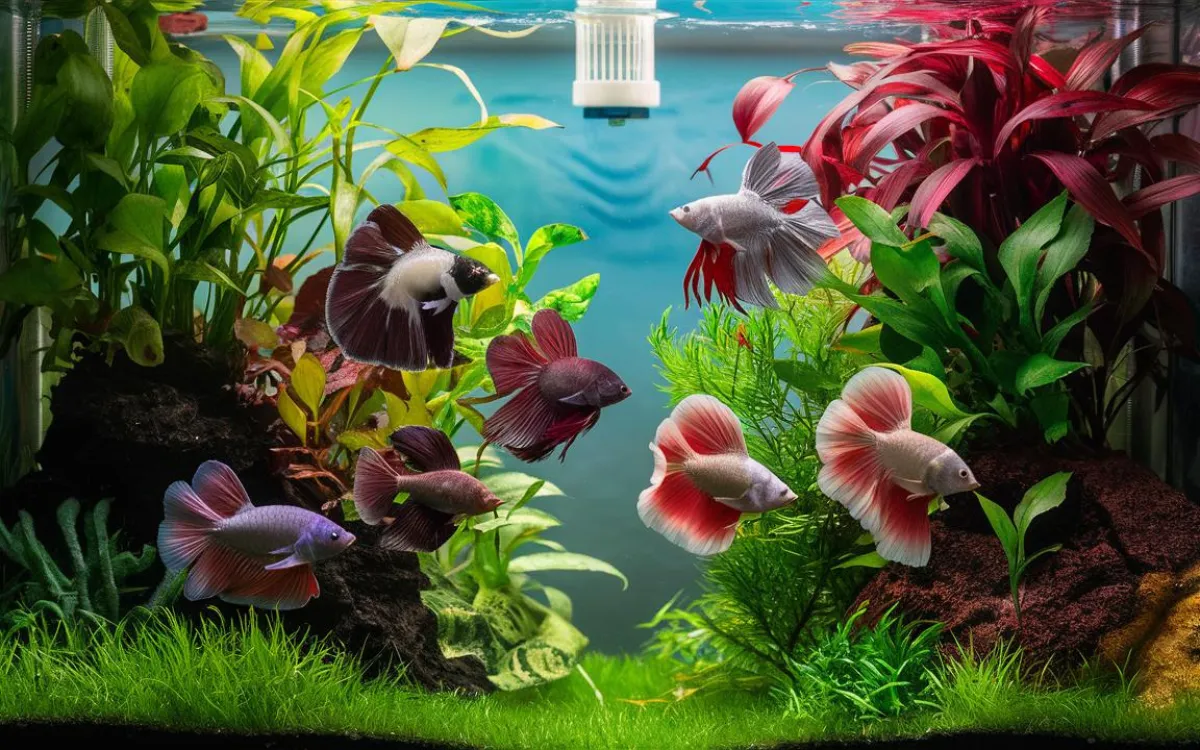Want to create a vibrant, active aquarium with multiple betta fish? Consider a betta sorority tank! Contrary to popular belief, keeping female bettas together is possible with the right setup and care.
Let’s find out with Betta Fish Information now!
Understanding the Dynamics of a Betta Sorority
While less aggressive than their male counterparts, female bettas can still exhibit territorial behavior. The key to a successful sorority lies in understanding their social dynamics and replicating their natural environment as closely as possible.
Here’s what you need to know:
Minimum Number
A common mistake is underestimating the importance of numbers in a betta sorority. Aim for a group of at least five female bettas. This minimum number is crucial for distributing any aggression that may arise. With fewer fish, a dominant individual can easily target a single tank mate, leading to constant stress and potential harm.
Tank Size
Never underestimate the importance of space in a betta sorority. While it might be tempting to opt for a smaller tank, a minimum 20-gallon tank is crucial for a five-fish sorority. Remember, bigger is always better! A larger tank provides ample space for swimming, exploring, and establishing territories, which significantly reduces stress and minimizes the likelihood of territorial disputes.
Similar Size and Age
Just like in any social group, differences in size and age can lead to imbalances in a betta sorority. Choose bettas of similar size and age to create a more even playing field. This reduces the likelihood of larger, more mature fish bullying smaller, younger ones. Sourcing your bettas from a local breeder is often a good strategy, as it allows you to see the fish in person and select individuals that are well-matched in terms of size and developmental stage.
Creating the Ideal Betta Sorority Tank Environment

Replicating a natural habitat is essential for a thriving betta sorority. This involves careful consideration of equipment, decor, and water parameters. A reliable heater is non-negotiable, as bettas thrive in warm water temperatures between 75°-81°F (23.8°-27.2°C). Since these fish are delicate swimmers, opt for a gentle filter like a sponge filter to avoid stressing them with strong currents.
Creating a sense of security and breaking up lines of sight within the tank is crucial. Dense planting and the inclusion of hiding spots like driftwood, live plants, rocks, caves, and other aquarium-safe decorations allow bettas to establish territories and seek refuge when needed.
Maintaining specific water parameters is also vital for their health: aim for a temperature of 75°-81°F (23.8°-27.2°C), 0 ppm of ammonia and nitrite, nitrate levels below 20 ppm, a pH between 6.5-7.5, general hardness (GH) of 3-4 dGH (50-66.7 ppm), and carbonate hardness (KH) of 3-5 dKH (53.6-89.4 ppm).
Feeding Your Betta Sorority
Proper feeding is crucial to minimize aggression and ensure each betta receives adequate nutrition. Choose a high-quality pelleted betta food as their staple diet, supplementing it occasionally with live or frozen foods like bloodworms or brine shrimp. Instead of one large feeding, offer several small meals throughout the day.
This aids digestion, reduces waste, and more closely mimics their natural feeding patterns. To prevent competition and ensure all bettas have access to food, distribute it in different areas of the tank. Regular maintenance and vigilant monitoring are also essential for a healthy betta sorority. Perform weekly water changes of 25%-50%, vacuuming the substrate to remove debris and uneaten food.
Carefully observe the bettas’ behavior. While some fin nipping and chasing are normal during the initial pecking order establishment, persistent aggression, injuries, or a betta constantly hiding may require intervention, such as separating aggressive individuals.
Is a Betta Sorority Right for You?
Setting up a betta sorority tank can be an incredibly rewarding experience, offering a unique opportunity to witness the captivating dynamics of these intelligent and visually stunning creatures. Unlike their male counterparts, often destined for solitary confinement due to their territorial nature, female bettas can thrive in carefully curated communities.
A well-planned sorority allows you to enjoy the vibrant colors and graceful movements of multiple females coexisting in a shared environment, creating a mesmerizing underwater ballet of fins and shimmering scales. However, achieving this harmonious balance requires more than simply placing a group of female bettas in a tank together and hoping for the best. It demands a deeper understanding of their natural behaviors, social cues, and environmental needs.
Conclusion
While setting up a betta sorority tank requires careful planning and ongoing attention, the rewards are immeasurable. By following the guidelines outlined in this comprehensive guide, you can create a thriving and harmonious environment for your female bettas, allowing you to enjoy the captivating beauty and fascinating social interactions of these underwater jewels for years to come.
Remember, a little research and a lot of love go a long way in ensuring a successful and rewarding betta sorority experience.

Related Posts
What Kind Of Water For Fish Tank? Perfect Water for Tank
DIY Aquarium Plants: Creating Your Own Underwater Oasis
How to Use Bio Media Effectively | Benefits of Bio Media